
The Metropolitan Archdiocese of Dubuque is a Latin Church ecclesiastical territory, or archdiocese, of the Catholic Church in the northeastern quarter of the state of Iowa in the United States.

Sacred Heart Cathedral, located in Davenport, Iowa, United States, is a Catholic cathedral and a parish church in the Diocese of Davenport. The cathedral is located on a bluff overlooking the Mississippi River to the east of Downtown Davenport. It is listed on the National Register of Historic Places as part of the Sacred Heart Roman Catholic Cathedral Complex. This designation includes the church building, rectory, and the former convent, which was torn down in 2012. The cathedral is adjacent to the Cork Hill Historic District, also on the National Register. Its location on Cork Hill, a section of the city settled by Irish immigrants.

The Diocese of Des Moines is a Latin Church ecclesiastical territory, or diocese, of the Catholic Church in southwestern Iowa in the United States. It is a suffragan see in the ecclesiastical province of the metropolitan Archdiocese of Dubuque. The see city for the diocese is Des Moines. The cathedral parish for the diocese is St. Ambrose.

St. Ambrose Cathedral is a historic building located in downtown Des Moines, Iowa, United States. It serves as a parish church and as the seat of the Diocese of Des Moines in the Catholic Church. The cathedral, along with the adjoining rectory, was listed on the National Register of Historic Places in 1979.

St. Mary's Catholic Church, also known as St. Mary of the Visitation Church, is a parish church of the Diocese of Davenport which is located in Iowa City, Iowa, United States. The church building and rectory were listed together on the National Register of Historic Places in 1980. They were both included as contributing properties in the Jefferson Street Historic District in 2004. The parish's first rectory, which is now a private home, is also listed on the National Register as St. Mary's Rectory. It is located a few blocks to the east of the present church location at 610 E. Jefferson St.

James Joseph Davis was an Irish-born prelate of the Roman Catholic Church. He served as the third bishop of the Diocese of Davenport in Iowa from 1906 to until his death in 1926.
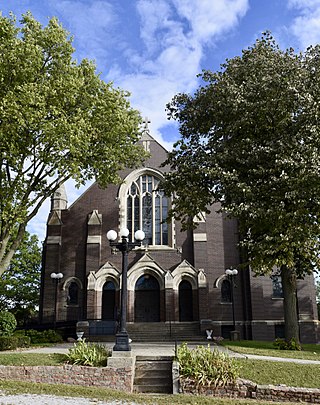
St. Patrick Church is located in Imogene, Iowa, United States. It is a Catholic parish church in the Diocese of Des Moines. It was listed on the National Register of Historic Places in 1983.

St. Mary's Catholic Church was a parish of the Diocese of Davenport. The church building is located in the west end of Davenport, Iowa, United States, at the corner of Fillmore and W. 6th Streets. It is listed on the National Register of Historic Places as St. Mary's Roman Catholic Church Complex. The designation includes the church building and rectory on the west side of Fillmore Street, and the former parochial school building and convent on the east side. A former school building operated by the parish two blocks north on West Eighth Street is also on the National Register and is listed as St. Mary's Academy. The parish ceased operations in July 2020 when it was merged into St. Anthony's Church downtown. The parish campus is being acquired by the nonprofit organization Humility Homes & Services, which is operated by the Congregation of the Humility of Mary.

St. Mary of the Visitation Catholic Church is a parish of the Diocese of Davenport. The church building is located on the corner of 4th and Court Streets in downtown Ottumwa, Iowa, United States. It is part of the Central Park area, which is the civic center of the community. It includes: the Wapello County Courthouse, the Ottumwa Public Library, and the Ottumwa City Hall. The church is eligible for the National Register of Historic Places, but it has not been listed.

St. Joseph's Catholic Church is a former parish of the Diocese of Davenport. The church is located in Dallas township in rural Marion County, Iowa, United States. It was part of the now defunct village of Bauer. The closest communities are Melcher-Dallas and Lacona. The church building still stands and together with the adjacent cemetery comprises an historic district listed on the National Register of Historic Places.

St. Michael's Catholic Church is a former parish of the Diocese of Davenport. The church is located in the unincorporated village of Holbrook, east of Parnell, Iowa, United States. It is listed on the National Register of Historic Places as St. Michael's Church, Cemetery, Rectory, and Ancient Order of Hibernians Hall in 1983.
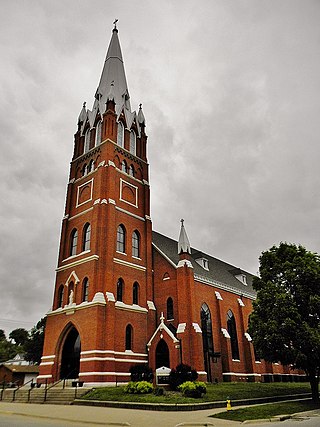
Holy Family Catholic Church is a parish of the Diocese of Davenport. The parish is the result of a merger between Saints Mary and Joseph Parish and Sacred Heart Parish in the city of Fort Madison, Iowa, United States. It maintains both of the former parish church buildings as worship sites. The oldest parish in town, St. Joseph, and St. Mary of the Assumption had merged in the 1990s. St. Mary of the Assumption Church, which became Saints Mary and Joseph, is located at 11th Street and Avenue E. It was individually listed on the National Register of Historic Places in 1980. Sacred Heart Church is located at 23rd Street and Ave I.

All Saints Catholic Church is a parish church building in the Diocese of Des Moines. The building is located in Stuart, Iowa, United States. The parish used the building as its church until a devastating fire severely damaged the structure. The church was rebuilt and it now serves as a cultural center called the Historic All Saints/Saints Center for Culture and the Arts. It is listed on the National Register of Historic Places, and is a rare example of Neo-Byzantine architecture in the state of Iowa.

St. Peter's Catholic Church is a parish of the Diocese of Des Moines. The church is located in Council Bluffs, Iowa, United States. It was listed on the National Register of Historic Places in 1992 as St. Peter's Church and Rectory.
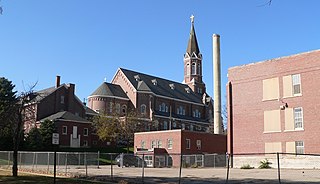
St. Boniface Catholic Church is a parish of the Diocese of Sioux City. The church is located in a residential area west of downtown Sioux City, Iowa, United States. The parish buildings form a nationally recognized historic district that was listed on the National Register of Historic Places in 1998 as St. Boniface Historic District. At the time of its nomination it contained three resources, all of them contributing buildings.
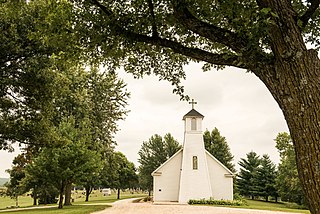
St. Patrick's Catholic Church is a parish church in the Diocese of Des Moines. The church was built in 1868 and is located southwest of the town of Cumming in rural Madison County, Iowa, United States. It was listed on the National Register of Historic Places in 1978. Pope John Paul II visited the church while he was on his first pastoral visit to the United States in 1979.
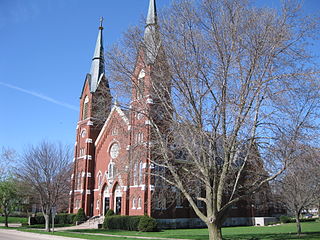
St. Boniface Church is a former parish church of the Diocese of Davenport. The church was founded in the town of Lyons, which is now the north side of Clinton, Iowa, United States. The church building is now a museum named The Catholic Historical Center at St. Boniface, with exhibits about the history of the Clinton area Catholic community, and an archive of local Catholic church artifacts and records. The church was listed on the National Register of Historic Places in 2012.

The St. Joseph's Church Complex is a collection of historic buildings located in Fort Madison, Iowa, United States. At one time the complex housed a Catholic parish in the Diocese of Davenport. St. Joseph and St. Mary of the Assumption parishes merged in the 1990s to form Saints Mary and Joseph Parish. In 2007 when that parish merged with Sacred Heart on the west side to form Holy Family Parish, St. Joseph's Church was closed. The former church, chapel, rectory, convent, and school were included as contributing properties in the Park-to-Park Residential Historic District that was listed on the National Register of Historic Places in 2014.

St. Augustin Catholic Church is a Catholic parish in the Diocese of Des Moines located on the west side of Des Moines, Iowa, United States. It was included as a contributing property in the Greenwood Park Plats Historic District and listed on the National Register of Historic Places in 2013.

St. Anthony's Catholic Church is a Catholic parish church in the Diocese of Des Moines located on the south side of Des Moines, Iowa, United States. It was listed on the National Register of Historic Places in 2021.























